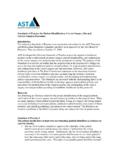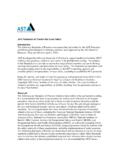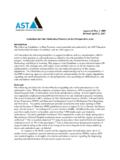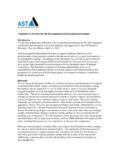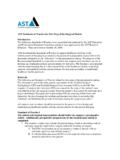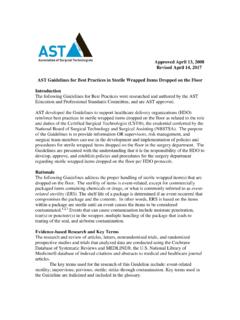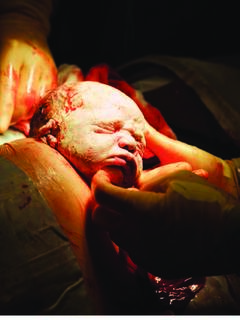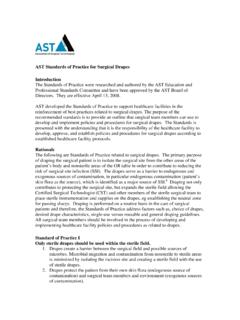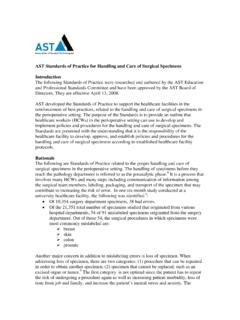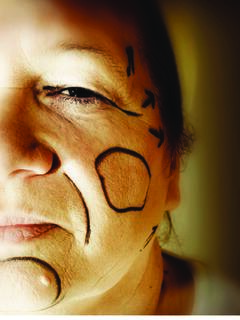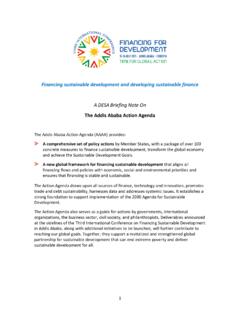Transcription of 308: Maslow's Hierarchy of Needs
1 AUGU S T 20 0 9 | the surgical technologist |347 maslow s Hierarchy of Needs is a valuable assessment tool that is used in many dif ferent professions, par ticularly those in the f ields of education and health care. the ideas of Needs are addressed in order, as the body r es olves the mo s t b as ic Needs f or sur v iv al bef or e mov ing on to mor e complex Needs . l e a r n i n g O B Je c t i v e ss identify the different levels of maslow s Hierarchy of needss Compare and contrast the differences between being Needs and deficit needss explain the process of self-actualizations examine how maslow s Hierarchy of Needs impacts patient cares Consider the challenges to maslow s theories and formulate a response Many educational programs in the health care field teach maslow s Hierarchy in order to address the Needs of patients and where they are in their life from a psycho-logical perspective.
2 Simply because it helps identify and address the Needs of those particular idea of using a Hierarchy pyramid helps us to lay out the stages of need, starting with the base of the pyramid, which looks at physiological Needs . As we work our way up the pyramid, the Needs start to become more complex, and include safety Needs , social Needs , esteem Needs , and finally, at the very top, we have self-actualization. This article explores the theories of Abraham maslow in detail, as well as addresses the controversies that have been questioned in his theory. This article will also evaluate the impact of these theories on human behavior and assess each of the components comprised within maslow s Hierarchy Pyramid.
3 B i o g r a p h i c a l o u t l i n eBorn on April 1, 1908, in Brooklyn, New York, Abraham maslow was the first of seven The son of under-educated Jew-ish immigrants, maslow didn t have many friends as a young by Bob Poston, c stA n E xercise in Personal E xploration: maslow s Hierarchy of Needs 2009 Association of Surgical Technologists For reprint permission: the surgical technologist | AUGU S T 20 0 9 348food and play, they would in more cases choose the food. The same was true when it came to the monkeys choice between water and food.
4 The water would always be chosen as the priority over the obser vations continued, a pattern emerged. maslow could see, on a physiological level, that if the mon-keys didn t have food, but had water, the group was less aggressive than those that had the water taken away from The same held true with safety Needs . If all of the physiologi-cal Needs were met, then the monkeys behavior became more profound when it came to establishing social roles and later transitioned this idea over to human behavior and was able to establish physiological Needs over safety Needs , safety Needs over belongingness Needs , belong-ingness Needs over esteem Needs , and esteem Needs .
5 The Needs , in turn, form the first four components of the pyra-mid, and are addressed as deficit Needs . Self-actualization, the fifth component, addresses the need of being, which defines one s own place in the universe. When an individual does not have enough of something, he or she has a deficit, ultimately creating what maslow has termed deficit Needs . 1 When individuals eat and drink, for example, the need for water and food is met, so there is no longer a motivating factor to obtain water or food, and the deficit need has temporarily been satisfied.
6 Deficit Needs comprise or make up the four lower components of maslow s Hierarchy the other hand, maslow also mentions the idea of being Needs . Being Needs have nothing to do with deficit Needs . Being Needs are internal, and are at the very top of maslow s Hierarchy pyramid, which ties into An example here might be drawing one s own conclu-sions of where and who he or she is spiritually. This internal concept is addressed as following sections of this article will address each level of maslow s Hierarchy of Needs in more detail in an effort to see how they apply to individuals, and how they can define who and where an individual is in his or her life.
7 Child, but found his sense of self by reading books. He began his college journey by attending City College of New York, and later transferred to Cornell University, before going back to City College of New York. After realizing a keen interest in psychology, he moved to Wisconsin, where he studied at the University of Wisconsin. Throughout the 1930s, maslow earned his BA, MA and Later, he returned to New York, where he not only taught full time at Brooklyn College, but he also became interested in human sexuality.
8 maslow ser ved as chair of the Department of Psy -chology at Brandeis from While there, he met a well-established researcher named Kurt Goldstein, who developed the idea of self-actualization. This concept fascinated maslow , and it was through this notion that he pursued the idea of humanistic psychology, which he ulti-mately valued more than his own research. maslow died on June 8, r e a t i n g t h e h i e r a r c h y o f n e e d sAbraham maslow is well known for the creation of the Hierarchy of Needs . The way he came up with this idea was by studying and observing monkeys.
9 During observa-tion, he noticed that they displayed a very unusual pattern of behavior that addressed priorities based on individual Needs . If, for example, the monkeys had a choice between BasicneedsPsychologicalneedsSelf-fulfull mentneedsSelf-actualization:achieving one sfull potential,including creativeactivitiesBelongingness and love Needs :intimate relationships, friendsSafety Needs :security, safetyPhysiological Needs :food, water, warmth, restEsteem Needs :prestige and feeling of accomplishmentFIGURE 1: maslow S Hierarchy PYRAMID 2009 Association of Surgical Technologists For reprint permission.
10 S T 20 0 9 | the surgical technologist |349PH Y S I O L O G I C A L NE E D SWith so many different capabilities, from the regulation of temperature and hormones to the processing of water, food and the elimination of waste, the living body is the most unique machine in the universe. Despite its relative fragility, the human body can live for many years. Every single detail is so integral, from how the body processes oxygen through millions and millions of tissue cells, to the thousands of miles of arteries that carry blood and nutrients to those tis-sues.
